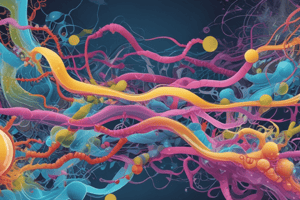Podcast
Questions and Answers
Where does protein digestion begin?
Where does protein digestion begin?
- Esophagus
- Large intestine
- Stomach (correct)
- Small intestine
What activates pepsinogens to become pepsins in the gastrointestinal tract?
What activates pepsinogens to become pepsins in the gastrointestinal tract?
- Intestinal bacteria
- Pancreatic enzymes
- Saliva
- Gastric acid (correct)
In what form are pepsins secreted in the stomach?
In what form are pepsins secreted in the stomach?
- Fats
- Inactive precursors (correct)
- Fully activated enzymes
- Proteins
Which type of pepsinogen is found only in acid-secreting regions?
Which type of pepsinogen is found only in acid-secreting regions?
What does maximal acid secretion correlate with in the context of pepsinogens?
What does maximal acid secretion correlate with in the context of pepsinogens?
What is the pH optimum range for pepsins during protein digestion?
What is the pH optimum range for pepsins during protein digestion?
Where does the action of pepsins get terminated during protein digestion?
Where does the action of pepsins get terminated during protein digestion?
What kind of bonds do pepsins hydrolyze during protein digestion?
What kind of bonds do pepsins hydrolyze during protein digestion?
Which enzyme acts at interior peptide bonds in peptide molecules during small intestine digestion?
Which enzyme acts at interior peptide bonds in peptide molecules during small intestine digestion?
Where is pepsinogen I predominantly found in the stomach?
Where is pepsinogen I predominantly found in the stomach?
Flashcards are hidden until you start studying
Study Notes
Protein Digestion
- Protein digestion begins in the stomach, where pepsins cleave some of the peptide linkages.
- Pepsins are secreted in the form of inactive precursors (proenzymes) and activated in the gastrointestinal tract.
- The pepsin precursors are called pepsinogens and are activated by gastric acid.
Pepsinogens
- Human gastric mucosa contains a number of related pepsinogens, which can be divided into two immunohistochemically distinct groups: pepsinogen I and pepsinogen II.
- Pepsinogen I is found only in acid-secreting regions, whereas pepsinogen II is also found in the pyloric region.
- Maximal acid secretion correlates with pepsinogen I levels.
Action of Pepsins
- Pepsins hydrolyze the bonds between aromatic amino acids (such as phenylalanine or tyrosine) and a second amino acid.
- The products of peptic digestion are polypeptides of very diverse sizes.
- Pepsins have a pH optimum of 1.6–3.2, and their action is terminated when the gastric contents are mixed with the alkaline pancreatic juice in the duodenum and jejunum.
Pancreatic and Intestinal Digestion
- In the small intestine, the polypeptides formed by digestion in the stomach are further digested by the powerful proteolytic enzymes of the pancreas and intestinal mucosa.
- Trypsin, the chymotrypsins, and elastase act at interior peptide bonds in the peptide molecules and are called endopeptidases.
- The pH of the intestinal contents in the duodenal bulb is 3.0–4.0, but rapidly rises; in the rest of the duodenum it is about 6.5.
Studying That Suits You
Use AI to generate personalized quizzes and flashcards to suit your learning preferences.


